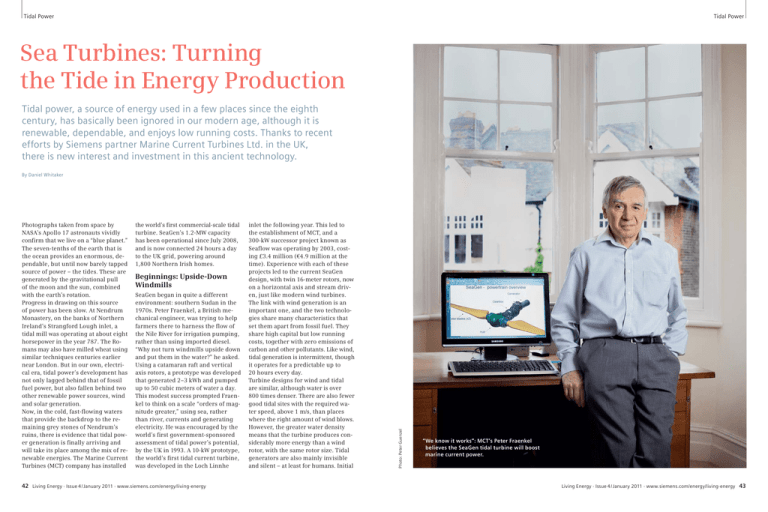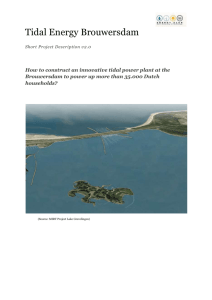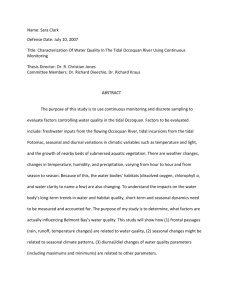Sea Turbines: Turning the Tide in Energy Production
advertisement

Tidal Power Tidal Power Sea Turbines: Turning the Tide in Energy Production Tidal power, a source of energy used in a few places since the eighth century, has basically been ignored in our modern age, although it is renewable, dependable, and enjoys low running costs. Thanks to recent efforts by Siemens partner Marine Current Turbines Ltd. in the UK, there is new interest and investment in this ancient technology. Photographs taken from space by NASA’s Apollo 17 astronauts vividly confirm that we live on a “blue planet.” The seven-tenths of the earth that is the ocean provides an enormous, dependable, but until now barely tapped source of power – the tides. These are generated by the gravitational pull of the moon and the sun, combined with the earth’s rotation. Progress in drawing on this source of power has been slow. At Nendrum Monastery, on the banks of Northern Ireland’s Strangford Lough inlet, a tidal mill was operating at about eight horsepower in the year 787. The Romans may also have milled wheat using similar techniques centuries earlier near London. But in our own, electrical era, tidal power’s development has not only lagged behind that of fossil fuel power, but also fallen behind two other renewable power sources, wind and solar generation. Now, in the cold, fast-flowing waters that provide the backdrop to the remaining grey stones of Nendrum’s ruins, there is evidence that tidal power generation is finally arriving and will take its place among the mix of renewable energies. The Marine Current Turbines (MCT) company has installed the world’s first commercial-scale tidal turbine. SeaGen’s 1.2-MW capacity has been operational since July 2008, and is now connected 24 hours a day to the UK grid, powering around 1,800 Northern Irish homes. Beginnings: Upside-Down Windmills SeaGen began in quite a different environment: southern Sudan in the 1970s. Peter Fraenkel, a British mechanical engineer, was trying to help farmers there to harness the flow of the Nile River for irrigation pumping, rather than using imported diesel. “Why not turn windmills upside down and put them in the water?” he asked. Using a catamaran raft and vertical axis rotors, a prototype was developed that generated 2–3 kWh and pumped up to 50 cubic meters of water a day. This modest success prompted Fraenkel to think on a scale “orders of magnitude greater,” using sea, rather than river, currents and generating electricity. He was encouraged by the world’s first government-sponsored assessment of tidal power’s potential, by the UK in 1993. A 10-kW prototype, the world’s first tidal current turbine, was developed in the Loch Linnhe 42 Living Energy · Issue 4 / January 2011 · www.siemens.com/energy/living-energy inlet the following year. This led to the establishment of MCT, and a 300-kW successor project known as Seaflow was operating by 2003, costing £3.4 million (€4.9 million at the time). Experience with each of these projects led to the current SeaGen design, with twin 16-meter rotors, now on a horizontal axis and stream driven, just like modern wind turbines. The link with wind generation is an important one, and the two technologies share many characteristics that set them apart from fossil fuel. They share high capital but low running costs, together with zero emissions of carbon and other pollutants. Like wind, tidal generation is intermittent, though it operates for a predictable up to 20 hours every day. Turbine designs for wind and tidal are similar, although water is over 800 times denser. There are also fewer good tidal sites with the required water speed, above 1 m/s, than places where the right amount of wind blows. However, the greater water density means that the turbine produces considerably more energy than a wind rotor, with the same rotor size. Tidal generators are also mainly invisible and silent – at least for humans. Initial Photo: Peter Guenzel By Daniel Whitaker “We know it works”: MCT’s Peter Fraenkel believes the SeaGen tidal turbine will boost marine current power. Living Energy · Issue 4 / January 2011 · www.siemens.com/energy/living-energy 43 Tidal Power “We Know It Works” There are a great number of tidal turbine designs, some to be tested at the European Marine Energy Centre (EMEC) in the Scottish Orkney Islands. As well as stream-driven concepts, barrages are an option for areas with high tidal ranges, which fill sluices as the sea rolls into an estuary, then run a turbine as it comes back out. But Glossary ■ Tidal Power: Since the Middle Ages, the ocean tides have been harnessed to generate energy. The inexhaustible power generated by the gravitational pull of the moon and the sun can be used in several ways. Tidal stream generators function similarly to wind turbines. The kinetic power of water flows is captured by various types of underwater rotors. Barrage systems resemble traditional hydropower dams that are placed across river estuaries. The water rising and falling with the tides is redirected into turbines. A barrage is quite expensive to build and may have a serious impact on the riverine ecosystem. Fraenkel confidently lists the advantages of SeaGen’s horizontal axial stream-driven approach: “It self-starts, it’s efficient (average peak efficiency of 48 percent), it produces grid-compliant power, you can control the pitch, and we know it works.” Pitch control allows SeaGen’s rotors to turn 180 degrees to generate electricity from both ebb and flood tides. “We are way ahead of the competition, further than anyone realizes. But that’s because the best way to win a race is to start long before the other runners.” This confidence also attracted the company’s managing director Martin Wright, who is “passionate about energy, and in no doubt that tidal generation will be useful to society as well as big business.” MCT’s most recent partner, since February 2010, is Siemens. Fraenkel points to a number of Siemens technologies that could be of use to MCT, from electrical pitch control to new generator concepts that might replace the SeaGen gearbox. In addition, as with most renewable sources, there may be transmission issues with a grid designed for thermal power plants – another area of Siemens experience. Wright believes that Siemens became interested in MCT because the German company is one that “values good technology.” Like the UK, Germany has a history with water-driven power, even if not as ancient as Nendrum Monastery. Water wheels were floated on the Rhine River 500 years ago, with their current-driven movement used to mill corn. The UK nonprofit group Carbon Trust predicts that tidal power could meet 15–20 percent of UK electricity needs over the long run, though Fraenkel says that MCT has so far identified about 5 percent of the UK market for stream-driven turbines, but this is a multibillion euro market even at that level. Worldwide, estimates see a potential capacity for tidal power of up to 800 TWh. Clearly, it will only ever be one part of the total energy mix, but a potentially important one for countries with the right sea currents and coastal features. 44 Living Energy · Issue 4 / January 2011 · www.siemens.com/energy/living-energy Harnessing tidal power in Northern Ireland’s Strangford Lough: At 1.2 MW, SeaGen is the world’s first commercial-scale tidal turbine. Apart from the UK, these are likely to include Japan, Korea, China, Canada (where MCT has its main international project), the USA, Chile, India, France, Australia, New Zealand, the Philippines and Indonesia. Capital Cost vs. Operating Cost The key to tidal power’s commercial success will be driving down its capital cost. As long as the moon orbits the earth, operating costs are likely to be limited to maintenance, insurance, and land leasing. At present, Wright estimates that the installed cost of tidal generation is just over double that of offshore wind power, which is currently at £3.2 to 3.5 million per MW. According to 2010 calculations by engineering consultancy Parsons Brinckerhoff, current energy cost for tidal is in the Photo: Thomas Ernsting fears that SeaGen posed a danger to seals and other animals in Strangford Lough proved unfounded. Wind power has developed much faster, with 159 GW of capacity installed by the end of 2009, compared to less than 2 MW of tidal current. Yet this gives tidal power developers a great chance to benefit from the steady advances made in the design of wind turbines. Fraenkel comments that “most developers in the tidal power field don’t read the literature on wind power, and see value in doing something different just for the sake of it. As a result, they are trying all manner of weird rotors which have already long been discounted in the wind sector.” (broad) range of 15 to 40 p/kWh (€0.18–0.47), compared to 15–20 pence for offshore wind and 5–10 pence for coal and nuclear. Over the long term, tidal power’s cost curve will decrease, unlike those of nonrenewables, for which costs will head in the other direction. Costs may be reduced by cheaper site survey and installation. But how long will it take for cost parity with coal and nuclear? And in which countries will there be sufficient political will to support the technology until then? Government involvement is indispensable for tidal power. MCT has benefited from a positive approach in the UK – such as a grant covering 60 percent of Seaflow’s project cost. But the last three years have been uncertain ones, not helped by global financial dislocation. “Frustration would be a beautiful understatement,” admits Wright. “We need a strong signal that there will be a market in tidal power.” The alternative is that Canada or the USA could snatch the lead that the UK has built up in tidal power technology, as well as the future jobs that will go with it. Unlike in the UK, projects are approved quickly on the other side of the Atlantic, and Canada may well have a feed-in tariff within the next few months. “You only have to look at the success of wind and solar in Germany and Denmark to see what difference such a tariff can make,” Wright points out. After all, nuclear power, steam turbines and gas turbines were also originally heavily boosted by government subsidies that have since paid off many times over. Having devoted more than three decades to tidal power’s development since the beginning on the banks of the Nile, Peter Fraenkel takes a longterm view. “I am an inveterate inventor,” he says, “and I’ve been a donkey chasing a carrot on a stick. But it still looks like a juicy carrot.” Freelance technology, economics and business journalist Daniel Whitaker divides his time between London and Madrid. His work has appeared in such prestigious publications as the Financial Times, the Times, the Observer, the Economist and the Daily Telegraph in the UK, as well as Cinco Días in Spain. Further Information www.marineturbines.com www.siemens.com/energy Living Energy · Issue 4 / January 2011 · www.siemens.com/energy/living-energy 45




